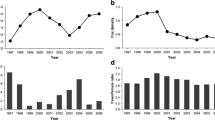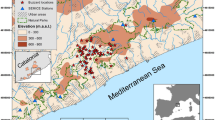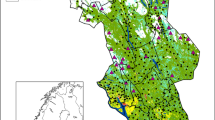Abstract
Three-to-five-year population oscillations of northern small rodents are usually synchronous over hundreds of square kilometers. This regional synchrony could be due to similarity in climatic factors, or due to nomadic predators reducing the patches of high prey density close to the average density of a larger area. We estimated avian predator and small rodent densities in 4–5 predator reduction and 4–5 control areas (c. 3 km2 each) during 1989–1992 in western Finland. We studied whether nomadic avian predators concentrate at high prey density areas, and whether this decreases spatial variation in prey density. The yearly mean number of avian predator breeding territories was 0.2–1.0 in reduction areas and 3.0–8.2 in control areas. Hunting birds of prey concentrated in high prey density areas after their breeding season (August), but not necessarily during the breeding season (April to June), when they were constrained to hunt in vicinity of the nest. The experimental reduction of breeding avian predators increased variation in prey density among areas but not within areas. The difference in variation between raptor reduction and control areas was largest in the late breeding season of birds of prey, and decreased rapidly after the breeding season. These results appeared to support the hypothesis that the geographic synchrony of population cycles in small mammals may be driven by nomadic predators concentrating in high prey density areas. Predation and climatic factors apparently are complementary, rather than exclusive, factors in contributing to the synchrony.
Similar content being viewed by others
References
Akeakaya HR (1992) Population cycles of mammals: evidence for ratio-dependent predation hypothesis. Ecol Monogr 62:119–142
Elton C (1942) Voles, mice and lemmings: problems in population dynamics. Oxford University Press, Oxford
Fretwell SD, Lucas JL Jr (1970) On territorial behaviour and other factors influencing habitat distribution in birds. I. Theoretical development. Acta Biotheor 19:16–36
Galushin VM (1974) Synchronous fluctuations in populations of some raptors and their prey. Acta Biotheor 116:127–132
Gerkema MP, Verhulst S (1990) Warning against unseen predator: a functional aspect of synchronous feeding in the common vole; Microtus arvalis. Anim Behav 40:1169–1178
Hakkarainen H, Korpimäki E, Mappes T, Palokangas P (1992) Kestrel hunting behaviour towards solitary and grouped Microtus agrestis and M. epiroticus—a laboratory experiment. Ann Zool Fenn 29:279–284
Hanski I, Turchin P, Korpimäki E, Henttonen H (1993) Population oscillations of boreal rodents: regulation by mustelid predators leads to chaos. Nature 364:232–235
Hansson L, Henttonen H (1988) Rodent dynamics as community processes. Trends Ecol Evol 3:195–200
Hörnfeldt B (1994) Delayed density dependence as a determinant of vole cycles. Ecology 75:791–806
Ims RA, Steen H (1990) Geographical synchrony in microtine population cycles: a theoretical evaluation of the role of nomadic predators. Oikos 57:381–387
Jedrzejewski W, Rychlik L, Jedrzejewska B (1993) Responses of bank voles to odours of seven species of predators: experimental data and their relevance to natural predator-vole relationships. Oikos 68:251–257
Kalela O (1962) On the fluctuations in the numbers of arctic and boreal small rodents as a problem of production biology. Ann Acad Sci Fenn A IV 66:1–38
Keith LB (1963) Wildlife's ten-year cycle. University of Wisconsin Press, Madison
Korpimäki E (1981) On the ecology and biology of Tengmalm's owl (Aegolius funereus) in southern Ostrobothnia and Suomenselkä western Finland. Acta Univ Oul A Biol 13:1–84
Korpimäki E (1985) Rapid tracking of microtine populations by their avian predators: possible evidence for stabilizing predation. Oikos 45:281–284
Korpimäki E (1994) Rapid or delayed tracking of multiannual vole cycles by avian predators? J Anim Ecol 63:619–628
Korpimäki E, Koivunen V, Hakkarainen H (1996) Microhabitat use and behaviour of voles under weasel and raptor predation risk: predator facilitation? Behav Ecol (in press)
Korpimäki E, Norrdahl K (1989) Predation of Tengmalm's owls: numerical responses, functional responses and dampening impact on population fluctuations of voles. Oikos 54:154–164
Korpimäki E, Norrdahl K (1991a) Do breeding nomadic avian predators dampen population fluctuations of small mammals? Oikos 62:195–208
Korpimäki E, Norrdahl K (1991b) Numerical and functional responses of kestrels, short-eared owls, and long-eared owls to vole densities. Ecology 72:814–826
Korpimäki E, Norrdahl K, Rinta-Jaskari T (1991) Responses of stoats and least weasels to fluctuating voles abundances: is the low phase of the vole cycle due to mustelid predation? Oecologia 88:552–561
Krebs CJ, Myers JH (1974) Population cycles in small mammals. Adv Ecol Res 8:267–399
Leslie PH (1959) The properties of a certain lag type of population growth and the influence of an external random factor on a number of such populations. Physiol Zool 32:151–159
Levin SA (1992) The problem of pattern and scale in ecology. Ecology 73:1943–1967
Longland WS, Price MV (1991) Direct observations of owls and heteromyid rodents: can predation risk explain microhabitat use? Ecology 72:2261–2273
Moran PAP (1953) The statistical analysis of the Canadian lynx cycle. II. Synchronization and meteorology. Aust J Zool 1: 291–298
Myllymäki A, Paasikallio A, Pankakoski E, Kanervo V (1971) Removal experiments on small quadrats as a means of rapid assessment of the abundance of small mammals. Ann Zool Fenn 8:177–185
Norrdahl K, Korpimäki E (1993) Predation and interspecific competition in two Microtus voles. Oikos 66:149–158
Norrdahl K, Korpimäki E (1995a) Effects of predator-removal on vertebrate prey populations: birds of prey and small mammals. Oecologia 103:241–248
Norrdahl K, Korpimäki E (1995b) Mortality factors in a cyclic vole population. Proc R Soc Lond B 261:49–53
Palokangas P, Alatalo RV, Korpimäki E (1992) Female choice in the kestrel under different availability of mating options. Anim Behav 43:659–665
Sinclair ARE, Gosline JM, Holdsworth G, Krebs CJ, Boutin S, Smith JNM, Boonstra R, Dale M (1993) Can the solar cycle and climate synchronize the snowshoe hare cycle in Canada? Evidence from tree rings and ice cores. Am Nat 141:173–198
Viitala J, Korpimäki E, Palokangas P, Koivula M (1995) Attraction of kestrels to vole scent marks visible in ultraviolet light. Nature 373:425–427
Ydenberg RC (1987) Nomadic predators and geographical synchrony in microtine population cycles. Oikos 50:270–272
Author information
Authors and Affiliations
Corresponding author
Rights and permissions
About this article
Cite this article
Norrdahl, K., Korpimäki, E. Do nomadic avian predators synchronize population fluctuations of small mammals? a field experiment. Oecologia 107, 478–483 (1996). https://doi.org/10.1007/BF00333938
Received:
Accepted:
Issue Date:
DOI: https://doi.org/10.1007/BF00333938




